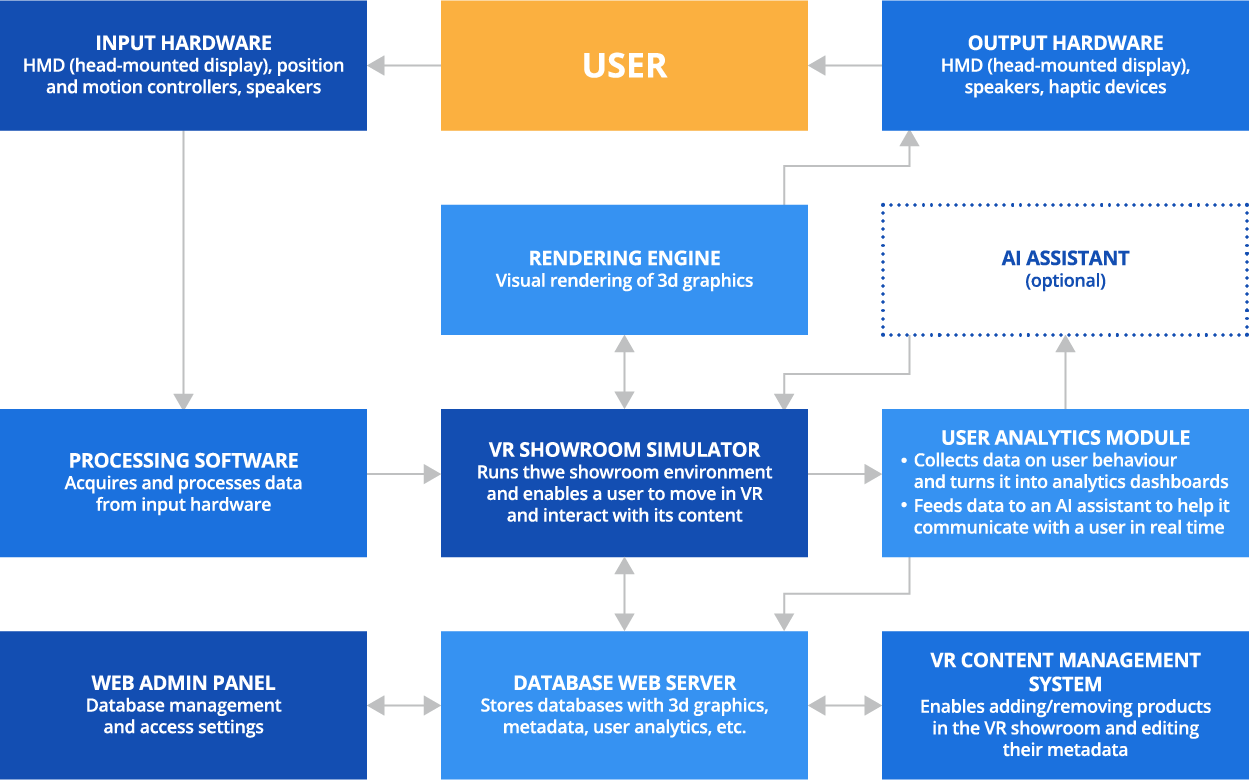Virtual Reality (VR) Showroom: A Tech Guide
With 35-year experience in software development and 28-year experience in 3D modeling, ScienceSoft offers comprehensive virtual reality development services.
Virtual Reality for Showrooms: The Essence
VR software for showrooms helps to increase sales, boost customer confidence in purchasing and reduce return rate by 60-80%, as well as improve customer experience and build brand loyalty.
Market Outline: Virtual Reality in Retail
The virtual reality software in retail is expected to bring $5.4 billion by 2028, from $2 Million in 2021, at a CAGR of 13.82%. The driving force behind VR adoption in retail is the growing demand for personalized customer experience and the need for new ways of brand differentiation.
How a Virtual Showroom Works
Use cases
Features
The set of features is defined individually based on each use case. Some of the common features are:
Customer-side:
Product discovery
- Product metadata check-up: pop-up displays with a product’s info (price, sizes, characteristics, etc.).
- Product customization: changing available product configurations (colors, patterns, tech specifications).
VR navigation tools
e.g., hotspot navigation: users can click or lock eyes on the labeled hotspots in the VR space to get teleported straight to them.
AI assistant
Helps navigate the simulation, gives personalized product recommendations based on what products a user interacts with.
Multiplayer
Enabling a group of users to join the VR simulation at the same time and from different locations.
Customizable avatars (for the multiplayer mode)
Users can choose an avatar to identify each other in the simulation.
Integration with payment services
and/or social media.
Business-side:
VR content management system
Adding/removing products or their configurations and editing their metadata.
User analytics
Collecting user behavior statistics (e.g., defining most and least popular products/features among users).
VR System Architecture

Examples of Virtual Showrooms
|
|
Natuzzi, a global furniture brand from Italy, has augmented their physical stores with virtual showrooms where customers can decorate a place with Natuzzi’s products. This initiative contributes to a 30-50% store sales increase during the most active months. |
|
|
For IFA 2020 trade show, LG launched an interactive virtual showroom highlighting the capabilities of their flexible OLED TV screens in different home-style zones. The showroom was available to consumers around the globe via web and mobile apps, thus broadening the audience that could engage with the brand in a new entertaining way. |
General Technology Stack
VR Showroom Development Challenges and Solutions
Challenge
In VR, the shape of 3D models is defined with a polygon mesh to enable their real-time rendering. As the rendering of highly polygonal models (with curves and complex textures, like many products in the VR showroom can have) is heavy on GPU, it slows down the simulation.
Cost Drivers of a Virtual Reality Showroom
Talking from ScienceSoft’s experience in VR projects, the cost of a virtual reality showroom will start at $150,000. The cost will vary depending on multiple factors:
Core cost drivers
- Method of capturing real-life content for VR (3D CAD rendering, 360° photography, laser scanning).
- Number of 3D models optimized for VR and software to render it.
- Complexity of interactive scenarios.
- The depth of VR testing.
Additional cost drivers
- VR hardware.
- Development of advanced modules and their integration with a VR app:
- User analytics.
- AI assistant.
- VR Content Management System (CMS).
Operational costs
- Cloud services (based on the volume of cloud resources demanded).
VR Showroom: Consulting and Development by ScienceSoft
ScienceSoft relies on 35-year experience in software development and 28-year experience in 3D modeling to deliver high-end virtual reality showrooms for various business sectors.
Virtual showroom: consulting
Our consultants:
- Help create/finalize the VR showroom concept.
- Choose the right tech stack.
- Design a scalable architecture.
- Define a VR development and management roadmap.
- Estimate TCO and ROI of the VR system.
Virtual showroom: development
The service covers all the stages of VR system creation:
- Business analysis and research.
- Software architecture design.
- UX and UI design.
- 3D modeling.
- VR development and testing.
- Continuous support and evolution.
About ScienceSoft
ScienceSoft is a globally operating IT consulting and software development company established in 1989. Our experience in novel technology helps us develop efficient virtual reality solutions, including virtual showrooms for B2C and B2B needs. Achieving project goals in spite of time and budget constraints, as well as changing requirements, is ScienceSoft's top priority. You set goals, we drive the project to fulfill them.

 Schedule a call
Schedule a call

 Schedule a call
Schedule a call